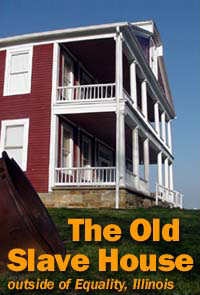 HICKORY HILL — The cornerstone for John Hart Crenshaw's manor house is dated 1838. Located outside Equality, Illinois, the Old Slave House, as it's better known, has long been the focus of stories of slavery associated the third floor. According to research conducted in the 1930s, even the ghost stories were in circulation as far back as 1851. Jon Musgrave photo |
|
So what do you think? Sign the Guestbook View the Guestbook
 |
|
The Lost Story Bonnell's account of Old Slave House first in print
EDITOR'S NOTE: Clarence Bonnell wrote this in 1920 for publication in the Transactions of the Illinois State Academy of Science. Years later while writing Illinois Ozarks (published in 1947), he noted he first learned of the stories surrounding Crenshaw's mansion four decades earlier after his arrival in Harrisburg in 1903. At the time of this writing Bonnell taught science at Harrisburg High School. He later also served as vice-principal at the school. Stories come to me of an "Underground Railroad" station about four miles southeast of Equality in Gallatin County. Upon a hilltop, stands a large two-story frame house conspicuous for its many large windows. It is a plain rectangular block of a house, with a well pitched roof having a deck something like twelve feet wide running the entire length. Just under the edge of the deck there are windows corresponding to the ventilators of a railway car. The gables have large window. The attic is said to have been reached by a narrow stairway. Along each side of the attic hall just under the sloping part of the roof there are bunks arranged, bunks just as the beds are situated in a Pullman car. One man relates that apparatus resembling stocks were seen the rubbish of this attic. The story is that it was built between 1838 and 1844 and was owned by Johnny Crenshaw. Some metal ornaments on the house are said to have come from England. Instead of this being an "underground" station for escaping slaves, so the story goes, this one was once used by a band operating as the automobile thieves of today. A free Negro or one escaping by flight, if found by this gang, was overpowered and conveyed by night under guard from farther north to this station. Another night journey took him to and across the Ohio River where his word was not accepted in court and where undisputed possession was evidence of ownership. The price that Negroes brought in those days was great enough to justify the risk taken by the captors. Some who have owned this house and lived in it tell this story as true. Others who were children in that day and lived only a few miles away claim no knowledge of such use of the property. This is explained on the ground that great secrecy was maintained by the owners. True or untrue, here is a story to stir the imagination.
The above article also appears on pages 123-124 in the new Handbook of Old Gallatin County and Southeastern Illinois now available from IllinoisHistory.com. The source for Bonnell's original acount is as follows: Clarence Bonnell. Winter 1921. "The Lore of the Illinois Ozarks." Transactions of the Illinois State Academy of Science. Springfield, Ill.: Illinois State Academy of Science. 14:1. 56-57. |
|||||||||
